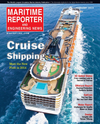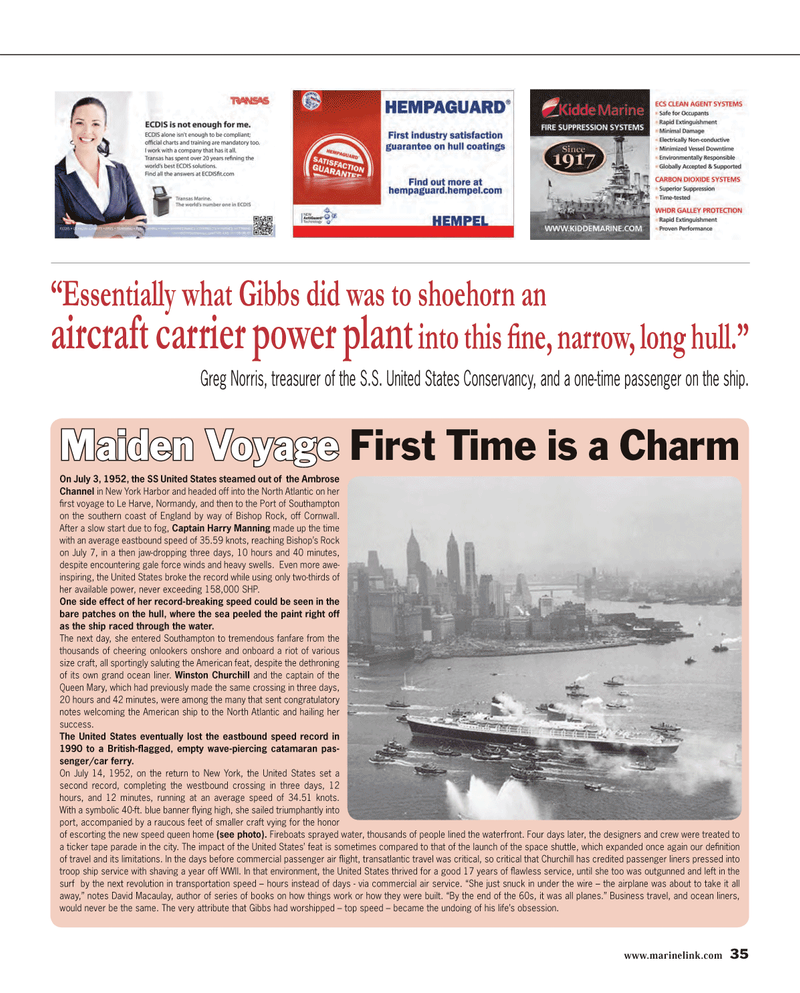
Page 35: of Maritime Reporter Magazine (February 2014)
Cruise Shipping Edition
Read this page in Pdf, Flash or Html5 edition of February 2014 Maritime Reporter Magazine
www.marinelink.com 35
Maiden VoyageMaiden V First Time is a Charm
On July 3, 1952, the SS United States steamed out of the Ambrose
Channel in New York Harbor and headed off into the North Atlantic on her fi rst voyage to Le Harve, Normandy, and then to the Port of Southampton on the southern coast of England by way of Bishop Rock, off Cornwall.
After a slow start due to fog, Captain Harry Manning made up the time with an average eastbound speed of 35.59 knots, reaching Bishop’s Rock on July 7, in a then jaw-dropping three days, 10 hours and 40 minutes, despite encountering gale force winds and heavy swells. Even more awe- inspiring, the United States broke the record while using only two-thirds of her available power, never exceeding 158,000 SHP.
One side effect of her record-breaking speed could be seen in the bare patches on the hull, where the sea peeled the paint right off as the ship raced through the water.
The next day, she entered Southampton to tremendous fanfare from the thousands of cheering onlookers onshore and onboard a riot of various size craft, all sportingly saluting the American feat, despite the dethroning of its own grand ocean liner. Winston Churchill and the captain of the
Queen Mary, which had previously made the same crossing in three days, 20 hours and 42 minutes, were among the many that sent congratulatory notes welcoming the American ship to the North Atlantic and hailing her success.
The United States eventually lost the eastbound speed record in 1990 to a British-fl agged, empty wave-piercing catamaran pas- senger/car ferry.
On July 14, 1952, on the return to New York, the United States set a second record, completing the westbound crossing in three days, 12 hours, and 12 minutes, running at an average speed of 34.51 knots.
With a symbolic 40-ft. blue banner fl ying high, she sailed triumphantly into port, accompanied by a raucous feet of smaller craft vying for the honor of escorting the new speed queen home (see photo). Fireboats sprayed water, thousands of people lined the waterfront. Four days later, the designers and crew were treated to a ticker tape parade in the city. The impact of the United States’ feat is sometimes compared to that of the launch of the space shuttle, which expanded once again our defi nition of travel and its limitations. In the days before commercial passenger air fl ight, transatlantic travel was critical, so critical that Churchill has credited passenger liners pressed into troop ship service with shaving a year off WWII. In that environment, the United States thrived for a good 17 years of fl awless service, until she too was outgunned and left in the surf by the next revolution in transportation speed – hours instead of days - via commercial air service. “She just snuck in under the wire – the airplane was about to take it all away,” notes David Macaulay, author of series of books on how things work or how they were built. “By the end of the 60s, it was all planes.” Business travel, and ocean liners, would never be the same. The very attribute that Gibbs had worshipped – top speed – became the undoing of his life’s obsession. “Essentially what Gibbs did was to shoehorn an aircraft carrier power plant into this fi ne, narrow, long hull.”
Greg Norris, treasurer of the S.S. United States Conservancy, and a one-time passenger on the ship.
MR #2 (32-41).indd 35 2/3/2014 10:24:49 AM

 34
34

 36
36
